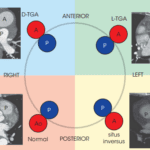What is Cor triatriatum?
Cor triatriatum is a rare congenital heart defect in which there is an abnormal membrane (fibromuscular septum) separating the left atrium of the heart into two chambers.
This can interfere with the normal flow of blood through the heart and lead to symptoms such as shortness of breath, fatigue, and rapid breathing.
Cor triatriatum is found in 0.1–0.4% of patients with congenital heart disease and is more common in men, with a 1.5 to 1 male-to-female ratio.
- 1. Cor triatriatum sinister
- Left atrium is divided by a membrane into a posterior-superior chamber that receives the 4 pulmonary veins and an anterior-inferior chamber that connects to the LV by means of the MV.
- Results from a failure of incorporation of the common pulmonary vein into the LA
- The chambers communicate through one or more openings
- High mortality rate if not repaired


The true atrium (TA) is connected to the mitral valve, while the false atrium (FA) receives the pulmonary veins.
- 2. Cor triatriatum dexter
- A membrane divides the Right atrium into two chambers
- Results from persistence of the right valve of the sinus venosus (ex. Eustachian or)
- Clinical manifestations, depending on the degree of partitioning or septation of the RA

Treatment of Cor triatriatum
1. Surgical resection of the dividing membrane
2. Percutaneous catheter disruption of the membrane
– a preferred alternative to open heart surgery.
3. Asymptomatic patients are generally not treated




